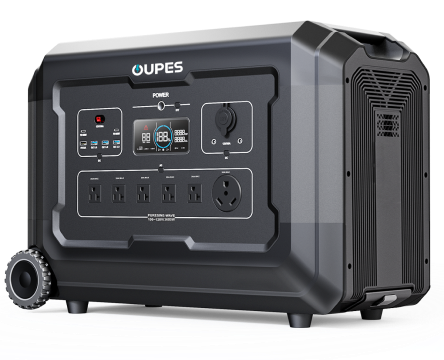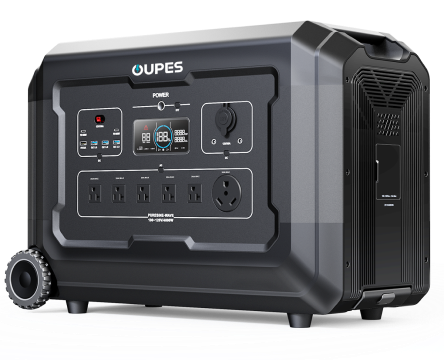Energy resources are in short supply, and electricity bills are rising rapidly. As a mighty pillar of new energy, solar energy is valued by more and more people. If you want to use solar energy well, choose solar panels. There are many types of solar panels. Next, this article will compare the monocrystalline and polycrystalline solar panels in detail.
What is a Monocrystalline Solar Panel?
A monocrystalline solar panel is crafted from singular-crystal solar cells, often referred to as "wafers." These wafers originate from a solitary silicon crystal, meticulously shaped into a cylindrical silicon ingot. Regarded as a superior solar product, monocrystalline panels boast elevated efficiency levels and a more refined visual appeal.
The essence of a monocrystalline cell lies in its singular crystal structure, which affords electrons an expanded arena for movement. This structural uniqueness endows monocrystalline solar cells with a heightened efficiency compared to their polycrystalline counterparts.
Opting for monocrystalline panels on your rooftop means requiring fewer units to generate a greater quantity of kWh of electricity, albeit at a higher cost per panel.
How Monocrystalline Solar Panels Work?
Monocrystalline solar panels use high-purity monocrystalline silicon cells to absorb sunlight and convert light into electrical energy. High-purity silicon can increase the solar energy conversion rate to 20%, significantly increasing the utilization rate of solar energy. However, the current is still direct current (DC) and cannot be directly used in homes and businesses. An inverter must also convert it into AC power before we can use it.
Monocrystalline Solar Panels Advantages & Disadvantages
Monocrystalline solar panels are ideals of efficiency and visual coherence in solar power.
Advantages:
- Monocrystalline panels: Highly efficient at 15-20%.
- Space-efficient: Maximize power per sq. ft.
- Versatile in all climates, low light.
- Durable due to unique crystal structure.
- They are aesthetically praised for their uniform design.
Disadvantages:
- Monocrystalline panels command a higher price.
Monocrystalline solar panels symbolize solar technological advancement, marrying high efficiency with aesthetic allure, though they come with a higher price tag. Their use in both private and public sectors highlights their versatility and dependability.
What Is The Polycrystalline Solar Panel?
Solar Panels are made by fusing silicon fragments into wafer panels. They are called polycrystalline solar panels constructed from multiple silicon crystals integrated into a single photovoltaic cell.
Due to the presence of multiple silicon crystals in the panel, the movement of electrons is restricted, and the efficiency is lower than that of a single-crystal panel. Moreover, silicon crystals are less resistant to high temperatures than pure silicon.
How Polycrystalline Solar Panels Work
Polycrystalline solar panels contain multiple electron-poor P-type materials and electron-rich N-type materials. When sunlight hits the PN structure within the solar panel, the collision activates electrons, generating an electric current in the power station.
Polycrystalline Solar Panels Advantages & Disadvantages
Advantages:
- Cost-effective and straightforward to make
- Greener production methods.
Disadvantages:
- Reduced efficiency (lower silicon purity)
- Susceptible to high-temperature damage
- Shorter lifespan, less aesthetically pleasing than monocrystalline panels
Polycrystalline solar panels offer a budget-friendly and greener alternative to solar technology, with some efficiency, durability, and aesthetics trade-offs.
Monocrystalline Vs. Polycrystalline Solar Panels
Cost
In the realm of solar energy, a discernible disparity in cost exists between monocrystalline and polycrystalline solar panels. This variance in expense should not lead to the hasty conclusion that monocrystalline panels are an imprudent choice. The quintessence of this cost divergence lies in the silicon architecture of these panels.
The genesis of polycrystalline panels involves the casting of liquefied silicon into quadrilateral molds, followed by the segmentation of the resultant slabs into discrete cells. In stark contrast, the fabrication of monocrystalline panels necessitates a meticulously orchestrated solidification of silicon, a process steeped in complexity. Such intricacy in manufacturing single-crystal solar cells inevitably escalates their price point.
In the realm of solar panel selection, it's pivotal to acknowledge that monocrystalline variants carry a heftier price tag. Concurrently, expenditures linked to inverters, conductive cabling, electrical safeguards, support structures, and artisanal labor remain constant across both panel types.
Moreover, the superior efficacy of monocrystalline panels may yield a more fruitful return on investment, particularly in scenarios where installation space is at a premium. It's also crucial to note that both monocrystalline and its counterpart are still beneficiaries of the federal solar tax incentive.
Efficiency
Ordinarily, monocrystalline solar panels surpass their polycrystalline counterparts in efficiency, primarily because they are hewn from a singular silicon crystal. This uniformity facilitates an unimpeded flow of electricity across the panel.
In certain scenarios, monocrystalline panels have demonstrated efficiencies exceeding 23%, a stark contrast to the sub-20% efficiency ceiling commonly observed in polycrystalline variants.
Lifespan
The variety of silicon cells constituting your photovoltaic modules typically bears no influence on the modules' longevity. Irrespective of whether they are monocrystalline or polycrystalline, these panels are adept at generating electricity with efficacy for a quarter of a century or even longer.
Temperature coefficient
In the realm of solar energy, monocrystalline panels surpass their polycrystalline counterparts in terms of thermal coefficient efficiency. This coefficient is a critical index reflecting a panel's efficacy under elevated thermal conditions, with figures gravitating towards nil indicating superior performance. Consequently, monocrystalline variants demonstrate enhanced resilience and efficiency in environments beset by higher temperatures.
|
Parameters |
Monocrystalline Solar Panels |
Polycrystalline Solar Panels |
|
Material |
Single Pure Silicon Crystal |
Different Silicon Fragments Molten Together |
|
Space Efficiency |
Efficient |
Less Efficient |
|
Conversion Efficiency |
15% to 20% |
13% to 16% |
|
Lifespan |
Minimum 25 Years |
Up to 25 Years |
|
Cost |
High |
Low |
|
Recyclability |
Yes |
Yes |
|
Temperature Coefficient |
-0.3% / c to -0.5% / c (High) |
-0.3% / c to -1% / c (Low) |
|
Appearance |
Uniform dark black squares with rounded edges |
Blue non-uniform squares with no rounded edges |
Best Portable Solar Panels With OUPES

OUPES Solar Panels are one of the best ways to utilize the sun's power. They are composed of monocrystalline solar cells. Connect the solar panels to the OUPES Explorer Portable Power Station to charge all home appliances.
Harness the sun's energy with solar panels, transforming sunlight into usable power, and store this energy in a lithium power station for later use. Opt for the OUPES Solar Generator, an ideal choice for off-grid energy needs or as a dependable backup power source. Its standout feature is portability – effortlessly transportable, this solar generator is perfect for various outdoor escapades, from camping to RV journeys and beyond.
OUPES 240W Solar Panel: Your Robust Energy Companion
- Power Packed: With a 240W (±5W) rating.
- Peak Efficiency: 21%-22% efficiency for superior energy conversion.
- Seamless Connection: Equipped with a 7909 DC Connector for easy integration.
- Voltage & Current Mastery: Boasts an Open Circuit Voltage of 21.4V and a Working Current of 12.1A.
- Elite Cell Technology: Crafted with Monocrystalline Silicon, high efficiency and durability.
- Manageable Heft: Weigh in at 18.48lb, sturdiness with portability.
- All-Weather Operation: Functions optimally between -10°C and 70°C (14℉ to 158℉).
- Trusted Warranty: Comes with a 12-month warranty, ensuring peace of mind.
OUPES 100W Solar Panel: Compact Power Redefined
- Optimized Power: Rated at 100W (±5W), ideal for smaller-scale energy needs.
- Efficient Energy Use: 20%-22% for maximizing power output.
- Reliable Connectivity: Features a 7909 DC Connector for consistent power flow.
- Voltage & Current Specs: Designed with a Power Voltage of 19.8v and a Power Current of 5A.
- Superior Cell Design: Utilizes Monocrystalline Silicon for long-lasting performance.
- Lightweight Build: At just 3.9kg, it's designed for easy transportation.
- Broad Temperature Range: Operates efficiently from -10°C to 70°C (14℉ to 158℉).
- Warranty Assurance: Backed by a 12-month warranty for quality assurance.
Warp Up
The OUPES Monocrystalline Solar Panels epitomize the forward strides in solar energy technology, amalgamating efficiency, resilience, and adaptability. Be it the formidable 240W model or its more diminutive 100W counterpart, these panels are ingeniously crafted to cater to a spectrum of energy requisites, ranging from expansive installations to mobile energy solutions.
Boasting high-efficiency ratings, robust monocrystalline silicon cells, and a design that thrives in diverse settings, OUPES Solar Panels transcend mere products; they embody a dependable and future-forward choice in sustainable energy. Their unwavering dedication to excellence and performance, underpinned by a comprehensive warranty, positions them as a prudent choice for those seeking to embrace solar energy's potential.

































Leave a comment
This site is protected by hCaptcha and the hCaptcha Privacy Policy and Terms of Service apply.